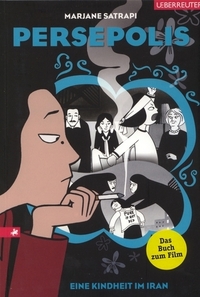You need to sign in or sign up before continuing.
Take a photo of a barcode or cover
The first half of Satrapi's retelling of her childhood growing up during the Islamic revolution. The starkness of her story pair well with the black-and-white drawings, and at times, add to the comic-y humor that lightens the tone. Though I haven't yet seen the movie, it seems like that translates well onto the screen.
There is an obvious reoccurring theme of death, which builds and builds throughout the plot. It starts with relatives of friends, distant associates, and other lesser known victims, and builds to greater forces. This cements itself well at the end when (view spoiler). Everything is very personal and very serious, especially for an almost teen who is still trying to make sense of what the government, her school, her parents say and how it all fits together.
There are very teenagerish moments in the book, such as when Satrapi compares her mother to a dictator. It is a good reminder that though she stays strong through protests, house searches, and bomb threats, she is still a child. We learn with her as she struggles to understand the government's decisions and how she and her family are treated as citizens.
Overall, I thought this was well done, and I look forward to reading the next installment.
There is an obvious reoccurring theme of death, which builds and builds throughout the plot. It starts with relatives of friends, distant associates, and other lesser known victims, and builds to greater forces. This cements itself well at the end when (view spoiler). Everything is very personal and very serious, especially for an almost teen who is still trying to make sense of what the government, her school, her parents say and how it all fits together.
There are very teenagerish moments in the book, such as when Satrapi compares her mother to a dictator. It is a good reminder that though she stays strong through protests, house searches, and bomb threats, she is still a child. We learn with her as she struggles to understand the government's decisions and how she and her family are treated as citizens.
Overall, I thought this was well done, and I look forward to reading the next installment.
challenging
dark
emotional
funny
hopeful
informative
reflective
challenging
emotional
funny
hopeful
informative
inspiring
reflective
sad
tense
medium-paced
“Nothing's worse than saying goodbye. It's a little like dying.”5/5 stars.
ebook, 341 pages (Complete Edition).
Read from March 7, 2021 to March 8, 2021.
Review at The Pluviophile Writer: https://bit.ly/3BUavv1
I can’t think of a more relevant book to read right now with the current news going on in the middle east…
Persepolis is separated into two parts (this book is the first), one covering the author’s childhood in Tehran and the second, covering her teen and young adult life in Vienna. Both stories are, at their root, a coming of age story and memoir amidst the turmoils of revolution and war. In the first part of the story, Marjane details her life from the ages of six to fourteen during the midst of the Islamic Revolution in Iran. Like the black and white images, the story details a stark contrast between Marjane’s private life and the life she must lead in public while also offering a child’s perspective to the serious changes affecting the entire country. Revolution, murder, and war was the setting that marked Marjane’s childhood and while Marjane’s parents always encouraged her outspokenness and independence it came at a cost. The first part of the book concludes with the major decision to move Marjane to Vienna to live with an extended family member.
Within the second book, Marjane adds the retrospect of her parent’s perspectives and their decision to send her away to Vienna as they feared for her safety if she stayed in Iran. This is where Marjane begins to come into her own as she tries desperately to fit into this new culture while recognising how different her upbringing and perspectives are to her new peers. She also has to learn to be abruptly independent as the family member she was placed to live with soon falls through. Marjane’s story details the awkwardness of growing up with both humour and, at times, surrealness as Marjane faces difficulties of which her peers have not. Persepolis is relatable yet at times an alien and horrifying story of youth, family, independence and connection.
Marjane’s artwork and style perfectly capture the humour, isolation, longing, horror, and frustration of the experiences she and her family experienced, making for a powerful and visceral read. It’s more important than ever to read books like Marjane’s as the turmoil she and her family experienced is still far from over for many families and women currently living in Afghanistan and other countries living with religious extremism and war.
Persepolis is easily one of the best graphic novels I’ve read. I would strongly recommend adding this book to your repertoire if you haven’t already. Whether you love or hate graphic novels or memoirs, I guarantee that this book will speak to you in one form or another.
adventurous
challenging
dark
emotional
funny
informative
inspiring
sad
challenging
dark
emotional
informative
medium-paced
A powerful book that takes the reader to Tehran during and after the Islamic Revolution that changed the face of Iran. Satrapi was a child of 6 when the world changed and from then through the age of 14, she is struggling to understand the changes in her country. I will definitely be seeking out the continuation of this memoir. Would have rated 4.5 if that was an option.
emotional
informative
reflective
sad
medium-paced
hopeful
informative
inspiring
reflective
sad
fast-paced
I thought that this book was very interesting and it taught me about the Islamic revolution. I also liked that it was a graphic-novel which made it fast paced among other things. Overall it was really good but I am just not really a fan of memoirs.
hopeful
informative
inspiring
reflective
tense
fast-paced
Incredibly informative! I’ve never read a memoir before, especially in this format, but the visuals really helped me picture the scenes and descriptions. I liked the narration voice and the comic style which reminded me of a short comic titled “Jamilti.” The journey of Satrapi’s childhood was intense in its emotional and historical significance from start to finish.






